sunroof BMW 650I XDRIVE COUPE 2015 Owners Manual
[x] Cancel search | Manufacturer: BMW, Model Year: 2015, Model line: 650I XDRIVE COUPE, Model: BMW 650I XDRIVE COUPE 2015Pages: 251, PDF Size: 7.22 MB
Page 21 of 251
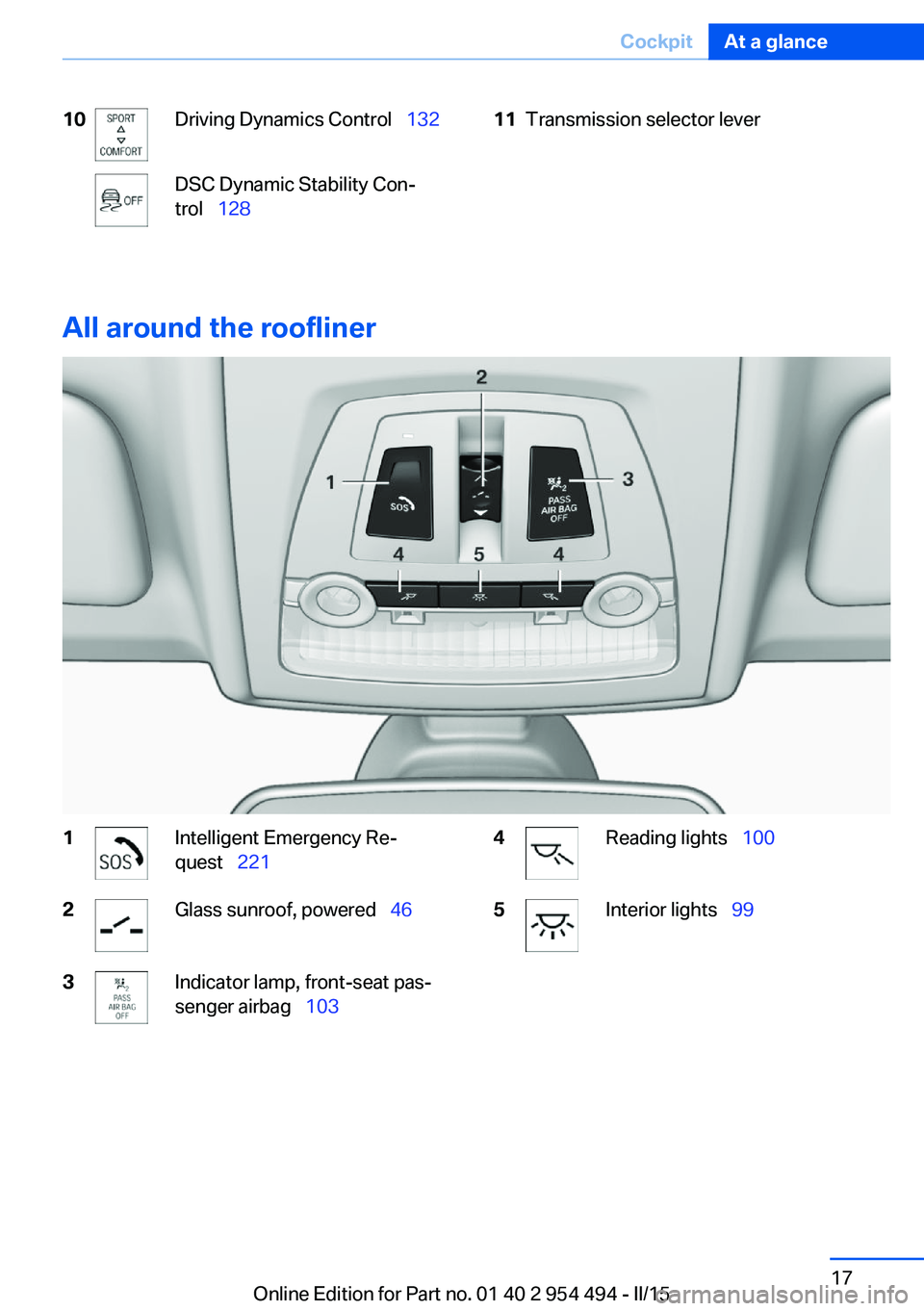
10Driving Dynamics Control‚ÄÇ‚ÄÖ132DSC Dynamic Stability Con‚Äê
trol‚ÄÇ‚ÄÖ 12811Transmission selector lever
All around the roofliner
1Intelligent Emergency Re‚Äê
quest‚ÄÇ‚ÄÖ 2212Glass sunroof, powered‚ÄÇ‚ÄÖ 463Indicator lamp, front-seat pas‚Äê
senger airbag‚ÄÇ‚ÄÖ 1034Reading lights‚ÄÇ‚ÄÖ 1005Interior lights‚ÄÇ‚ÄÖ99Seite 17CockpitAt a glance17
Online Edition for Part no. 01 40 2 954 494 - II/15
Page 42 of 251
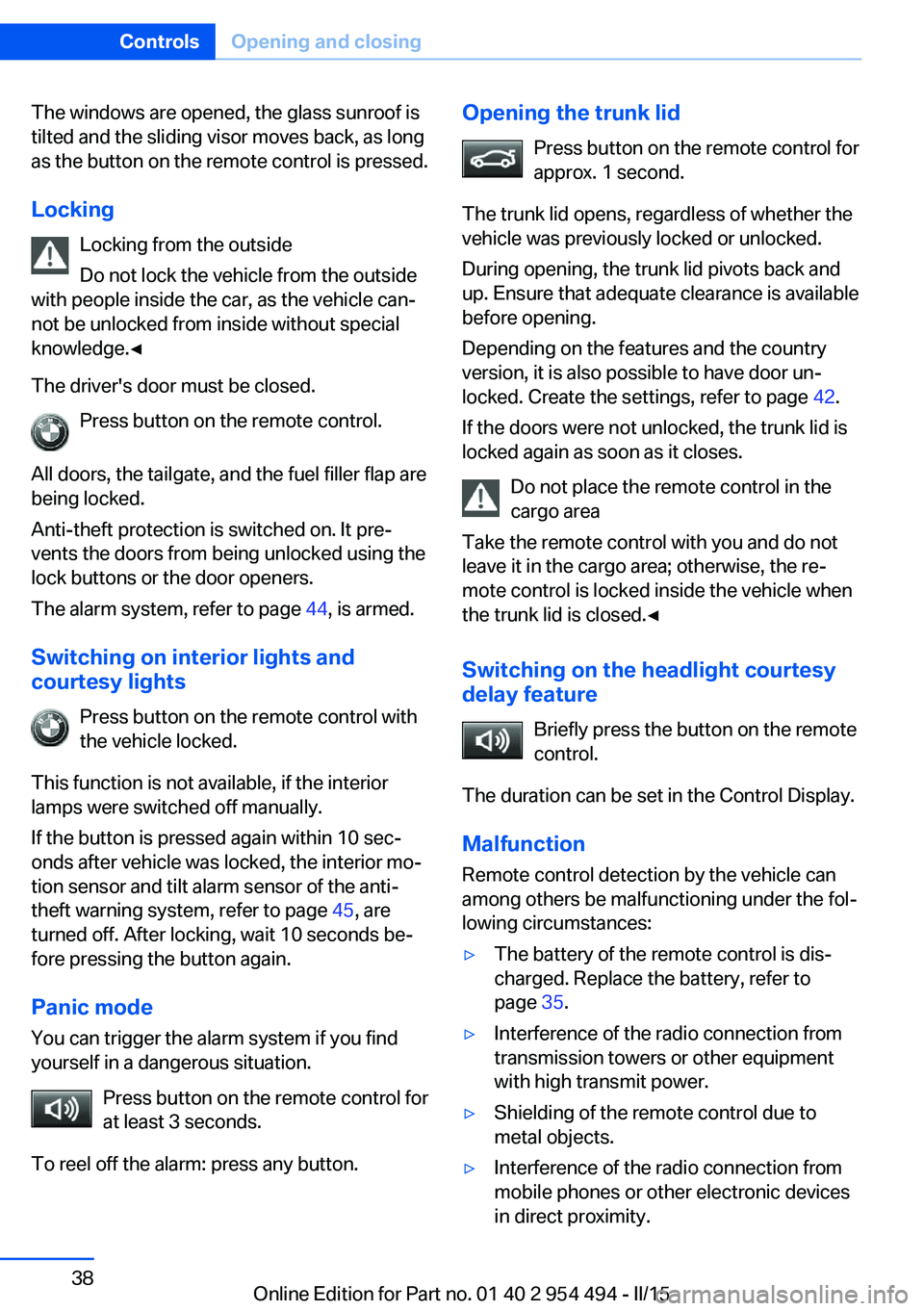
The windows are opened, the glass sunroof is
tilted and the sliding visor moves back, as long
as the button on the remote control is pressed.
Locking Locking from the outside
Do not lock the vehicle from the outside
with people inside the car, as the vehicle can‚Äê
not be unlocked from inside without special
knowledge.‚óÄ
The driver's door must be closed. Press button on the remote control.
All doors, the tailgate, and the fuel filler flap are
being locked.
Anti-theft protection is switched on. It pre‚Äê
vents the doors from being unlocked using the
lock buttons or the door openers.
The alarm system, refer to page 44, is armed.
Switching on interior lights and
courtesy lights
Press button on the remote control with
the vehicle locked.
This function is not available, if the interior
lamps were switched off manually.
If the button is pressed again within 10 sec‚Äê
onds after vehicle was locked, the interior mo‚Äê
tion sensor and tilt alarm sensor of the anti-
theft warning system, refer to page 45, are
turned off. After locking, wait 10 seconds be‚Äê
fore pressing the button again.
Panic mode
You can trigger the alarm system if you find
yourself in a dangerous situation.
Press button on the remote control for
at least 3 seconds.
To reel off the alarm: press any button.Opening the trunk lid Press button on the remote control for
approx. 1 second.
The trunk lid opens, regardless of whether the
vehicle was previously locked or unlocked.
During opening, the trunk lid pivots back and
up. Ensure that adequate clearance is available
before opening.
Depending on the features and the country
version, it is also possible to have door un‚Äê
locked. Create the settings, refer to page 42.
If the doors were not unlocked, the trunk lid is
locked again as soon as it closes.
Do not place the remote control in the
cargo area
Take the remote control with you and do not
leave it in the cargo area; otherwise, the re‚Äê
mote control is locked inside the vehicle when
the trunk lid is closed.‚óÄ
Switching on the headlight courtesy
delay feature
Briefly press the button on the remote
control.
The duration can be set in the Control Display.
Malfunction
Remote control detection by the vehicle can
among others be malfunctioning under the fol‚Äê
lowing circumstances:‚ñ∑The battery of the remote control is dis‚Äê
charged. Replace the battery, refer to
page 35.‚ñ∑Interference of the radio connection from
transmission towers or other equipment
with high transmit power.‚ñ∑Shielding of the remote control due to
metal objects.‚ñ∑Interference of the radio connection from
mobile phones or other electronic devices
in direct proximity.Seite 38ControlsOpening and closing38
Online Edition for Part no. 01 40 2 954 494 - II/15
Page 46 of 251
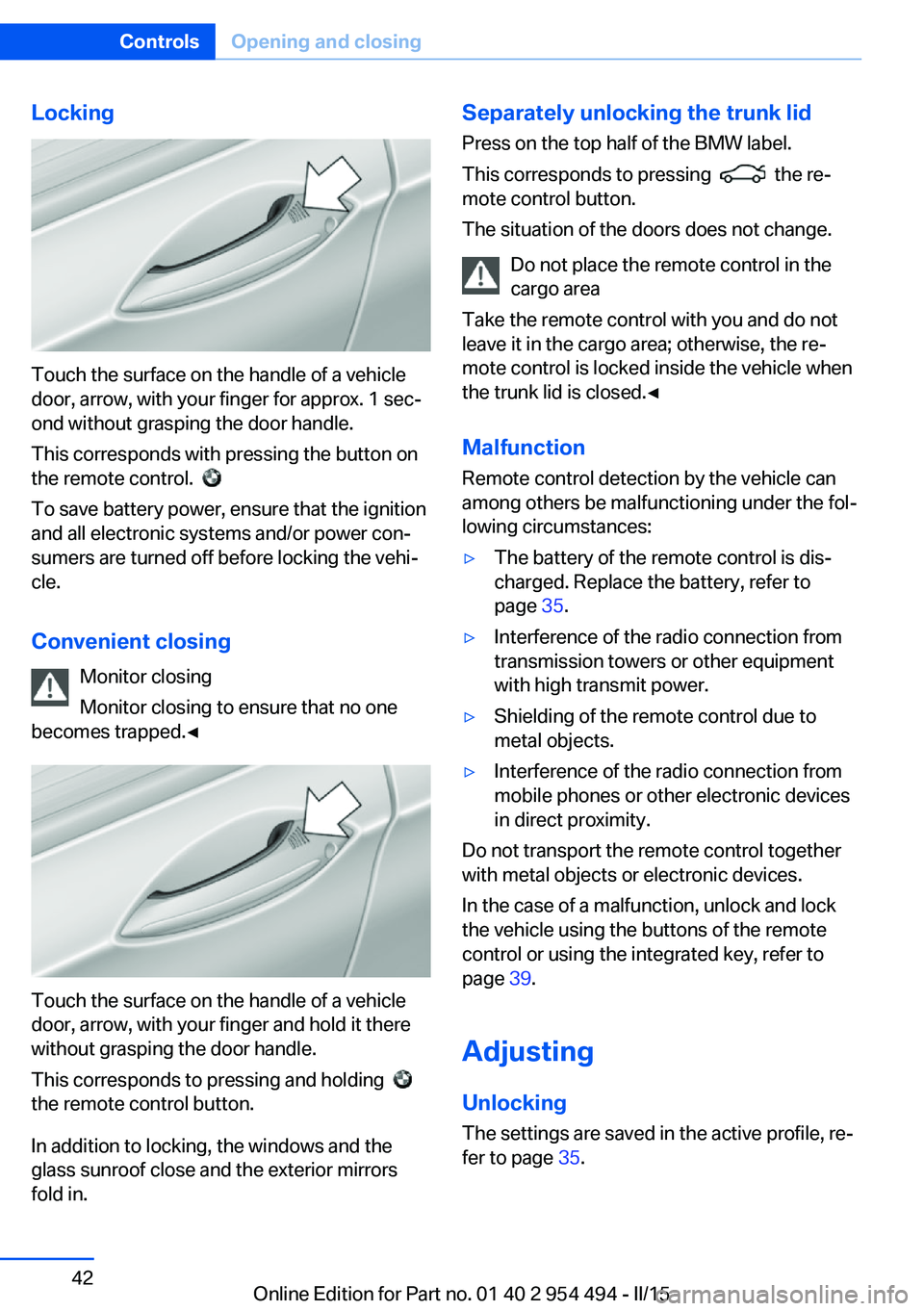
Locking
Touch the surface on the handle of a vehicle
door, arrow, with your finger for approx. 1 sec‚Äê
ond without grasping the door handle.
This corresponds with pressing the button on
the remote control.
To save battery power, ensure that the ignition
and all electronic systems and/or power con‚Äê
sumers are turned off before locking the vehi‚Äê
cle.
Convenient closing Monitor closing
Monitor closing to ensure that no one
becomes trapped.‚óÄ
Touch the surface on the handle of a vehicle
door, arrow, with your finger and hold it there
without grasping the door handle.
This corresponds to pressing and holding
the remote control button.
In addition to locking, the windows and the
glass sunroof close and the exterior mirrors
fold in.
Separately unlocking the trunk lid
Press on the top half of the BMW label.
This corresponds to pressing
the re‚Äê
mote control button.
The situation of the doors does not change.
Do not place the remote control in the
cargo area
Take the remote control with you and do not
leave it in the cargo area; otherwise, the re‚Äê
mote control is locked inside the vehicle when
the trunk lid is closed.‚óÄ
Malfunction
Remote control detection by the vehicle can
among others be malfunctioning under the fol‚Äê
lowing circumstances:
‚ñ∑The battery of the remote control is dis‚Äê
charged. Replace the battery, refer to
page 35.‚ñ∑Interference of the radio connection from
transmission towers or other equipment
with high transmit power.‚ñ∑Shielding of the remote control due to
metal objects.‚ñ∑Interference of the radio connection from
mobile phones or other electronic devices
in direct proximity.
Do not transport the remote control together
with metal objects or electronic devices.
In the case of a malfunction, unlock and lock
the vehicle using the buttons of the remote
control or using the integrated key, refer to
page 39.
Adjusting
Unlocking The settings are saved in the active profile, re‚Äê
fer to page 35.
Seite 42ControlsOpening and closing42
Online Edition for Part no. 01 40 2 954 494 - II/15
Page 48 of 251
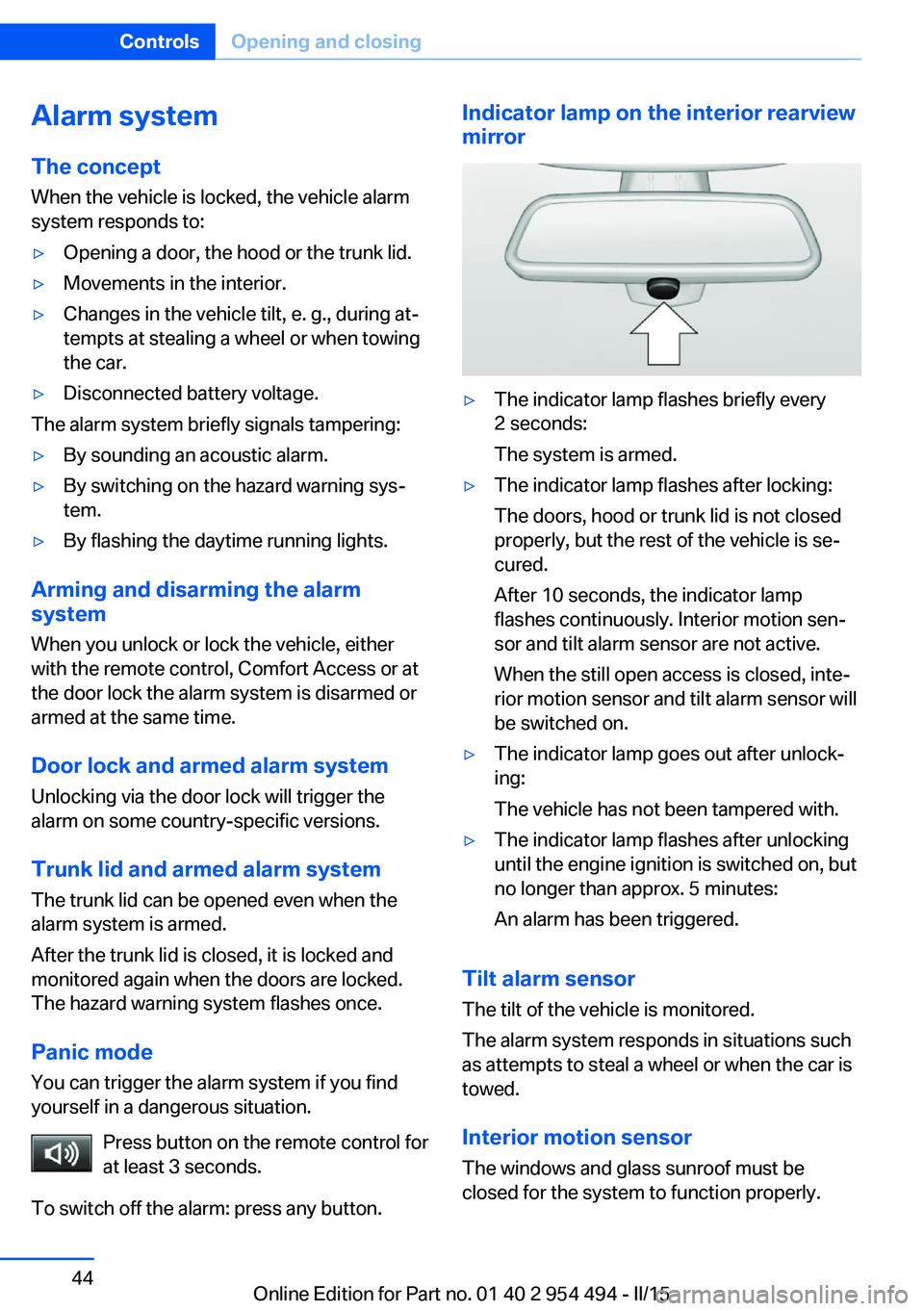
Alarm systemThe conceptWhen the vehicle is locked, the vehicle alarm
system responds to:‚ñ∑Opening a door, the hood or the trunk lid.‚ñ∑Movements in the interior.‚ñ∑Changes in the vehicle tilt, e. g., during at‚Äê
tempts at stealing a wheel or when towing
the car.‚ñ∑Disconnected battery voltage.
The alarm system briefly signals tampering:
‚ñ∑By sounding an acoustic alarm.‚ñ∑By switching on the hazard warning sys‚Äê
tem.‚ñ∑By flashing the daytime running lights.
Arming and disarming the alarm
system
When you unlock or lock the vehicle, either
with the remote control, Comfort Access or at
the door lock the alarm system is disarmed or
armed at the same time.
Door lock and armed alarm systemUnlocking via the door lock will trigger the
alarm on some country-specific versions.
Trunk lid and armed alarm system The trunk lid can be opened even when the
alarm system is armed.
After the trunk lid is closed, it is locked and
monitored again when the doors are locked.
The hazard warning system flashes once.
Panic mode
You can trigger the alarm system if you find
yourself in a dangerous situation.
Press button on the remote control for
at least 3 seconds.
To switch off the alarm: press any button.
Indicator lamp on the interior rearview
mirror‚ñ∑The indicator lamp flashes briefly every
2 seconds:
The system is armed.‚ñ∑The indicator lamp flashes after locking:
The doors, hood or trunk lid is not closed
properly, but the rest of the vehicle is se‚Äê
cured.
After 10 seconds, the indicator lamp
flashes continuously. Interior motion sen‚Äê
sor and tilt alarm sensor are not active.
When the still open access is closed, inte‚Äê
rior motion sensor and tilt alarm sensor will
be switched on.‚ñ∑The indicator lamp goes out after unlock‚Äê
ing:
The vehicle has not been tampered with.‚ñ∑The indicator lamp flashes after unlocking
until the engine ignition is switched on, but
no longer than approx. 5 minutes:
An alarm has been triggered.
Tilt alarm sensor The tilt of the vehicle is monitored.
The alarm system responds in situations such
as attempts to steal a wheel or when the car is
towed.
Interior motion sensor The windows and glass sunroof must be
closed for the system to function properly.
Seite 44ControlsOpening and closing44
Online Edition for Part no. 01 40 2 954 494 - II/15
Page 50 of 251
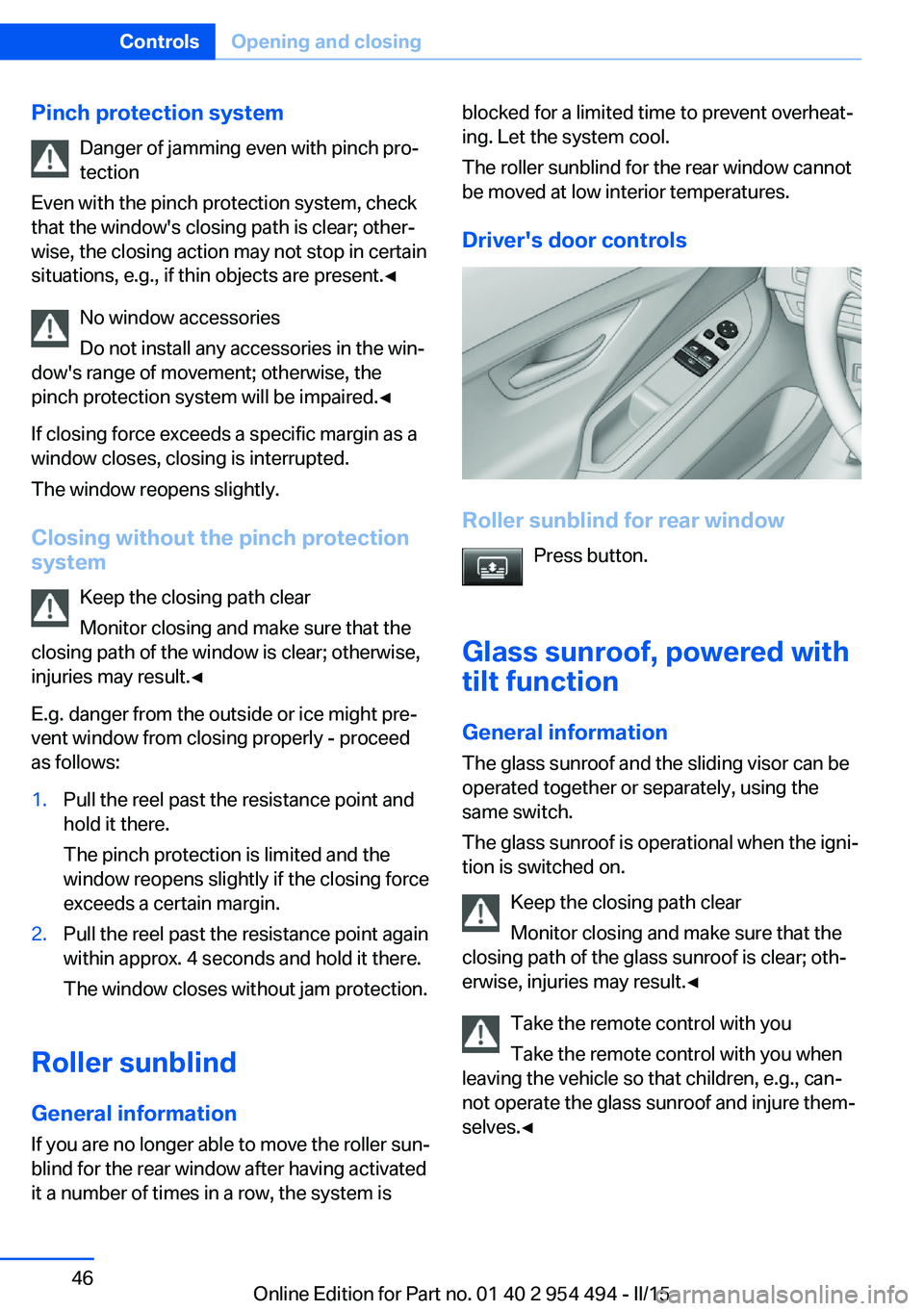
Pinch protection systemDanger of jamming even with pinch pro‚Äê
tection
Even with the pinch protection system, check
that the window's closing path is clear; other‚Äê
wise, the closing action may not stop in certain
situations, e.g., if thin objects are present.‚óÄ
No window accessories
Do not install any accessories in the win‚Äê
dow's range of movement; otherwise, the
pinch protection system will be impaired.‚óÄ
If closing force exceeds a specific margin as a
window closes, closing is interrupted.
The window reopens slightly.
Closing without the pinch protection
system
Keep the closing path clear
Monitor closing and make sure that the
closing path of the window is clear; otherwise,
injuries may result.‚óÄ
E.g. danger from the outside or ice might pre‚Äê
vent window from closing properly - proceed
as follows:1.Pull the reel past the resistance point and
hold it there.
The pinch protection is limited and the
window reopens slightly if the closing force
exceeds a certain margin.2.Pull the reel past the resistance point again
within approx. 4 seconds and hold it there.
The window closes without jam protection.
Roller sunblind
General information
If you are no longer able to move the roller sun‚Äê
blind for the rear window after having activated
it a number of times in a row, the system is
blocked for a limited time to prevent overheat‚Äê
ing. Let the system cool.
The roller sunblind for the rear window cannot
be moved at low interior temperatures.
Driver's door controls
Roller sunblind for rear window Press button.
Glass sunroof, powered with tilt function
General information The glass sunroof and the sliding visor can be
operated together or separately, using the
same switch.
The glass sunroof is operational when the igni‚Äê
tion is switched on.
Keep the closing path clear
Monitor closing and make sure that the
closing path of the glass sunroof is clear; oth‚Äê
erwise, injuries may result.‚óÄ
Take the remote control with you
Take the remote control with you when
leaving the vehicle so that children, e.g., can‚Äê
not operate the glass sunroof and injure them‚Äê
selves.‚óÄ
Seite 46ControlsOpening and closing46
Online Edition for Part no. 01 40 2 954 494 - II/15
Page 51 of 251
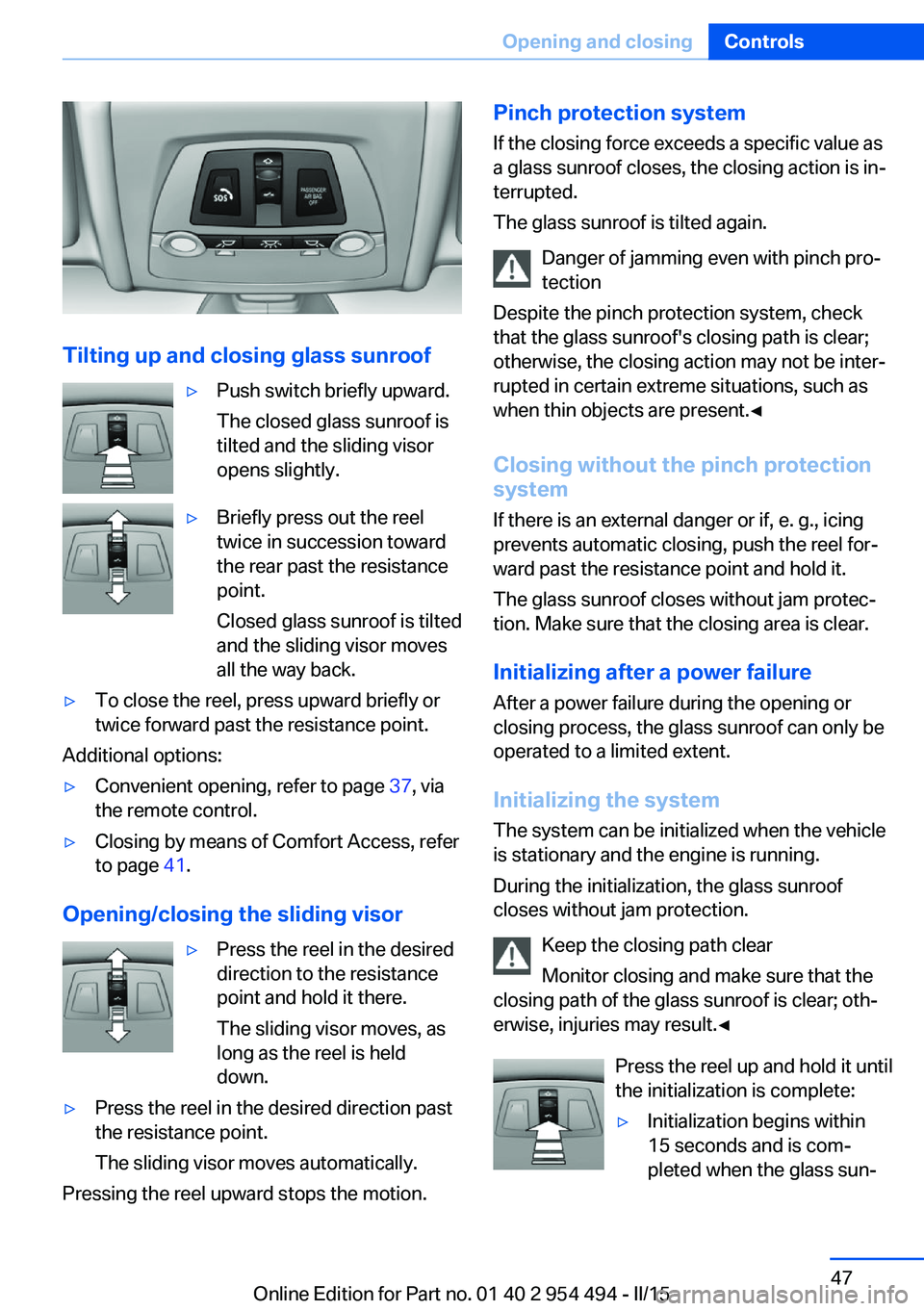
Tilting up and closing glass sunroof
‚ñ∑Push switch briefly upward.
The closed glass sunroof is
tilted and the sliding visor
opens slightly.‚ñ∑Briefly press out the reel
twice in succession toward
the rear past the resistance
point.
Closed glass sunroof is tilted
and the sliding visor moves
all the way back.‚ñ∑To close the reel, press upward briefly or
twice forward past the resistance point.
Additional options:
‚ñ∑Convenient opening, refer to page 37, via
the remote control.‚ñ∑Closing by means of Comfort Access, refer
to page 41.
Opening/closing the sliding visor
‚ñ∑Press the reel in the desired
direction to the resistance
point and hold it there.
The sliding visor moves, as
long as the reel is held
down.‚ñ∑Press the reel in the desired direction past
the resistance point.
The sliding visor moves automatically.
Pressing the reel upward stops the motion.
Pinch protection system If the closing force exceeds a specific value as
a glass sunroof closes, the closing action is in‚Äê
terrupted.
The glass sunroof is tilted again.
Danger of jamming even with pinch pro‚Äê
tection
Despite the pinch protection system, check
that the glass sunroof's closing path is clear;
otherwise, the closing action may not be inter‚Äê
rupted in certain extreme situations, such as
when thin objects are present.‚óÄ
Closing without the pinch protection
system
If there is an external danger or if, e. g., icing
prevents automatic closing, push the reel for‚Äê
ward past the resistance point and hold it.
The glass sunroof closes without jam protec‚Äê
tion. Make sure that the closing area is clear.
Initializing after a power failure After a power failure during the opening or
closing process, the glass sunroof can only be
operated to a limited extent.
Initializing the system
The system can be initialized when the vehicle
is stationary and the engine is running.
During the initialization, the glass sunroof
closes without jam protection.
Keep the closing path clear
Monitor closing and make sure that the
closing path of the glass sunroof is clear; oth‚Äê
erwise, injuries may result.‚óÄ
Press the reel up and hold it until
the initialization is complete:‚ñ∑Initialization begins within
15 seconds and is com‚Äê
pleted when the glass sun‚ÄêSeite 47Opening and closingControls47
Online Edition for Part no. 01 40 2 954 494 - II/15
Page 52 of 251
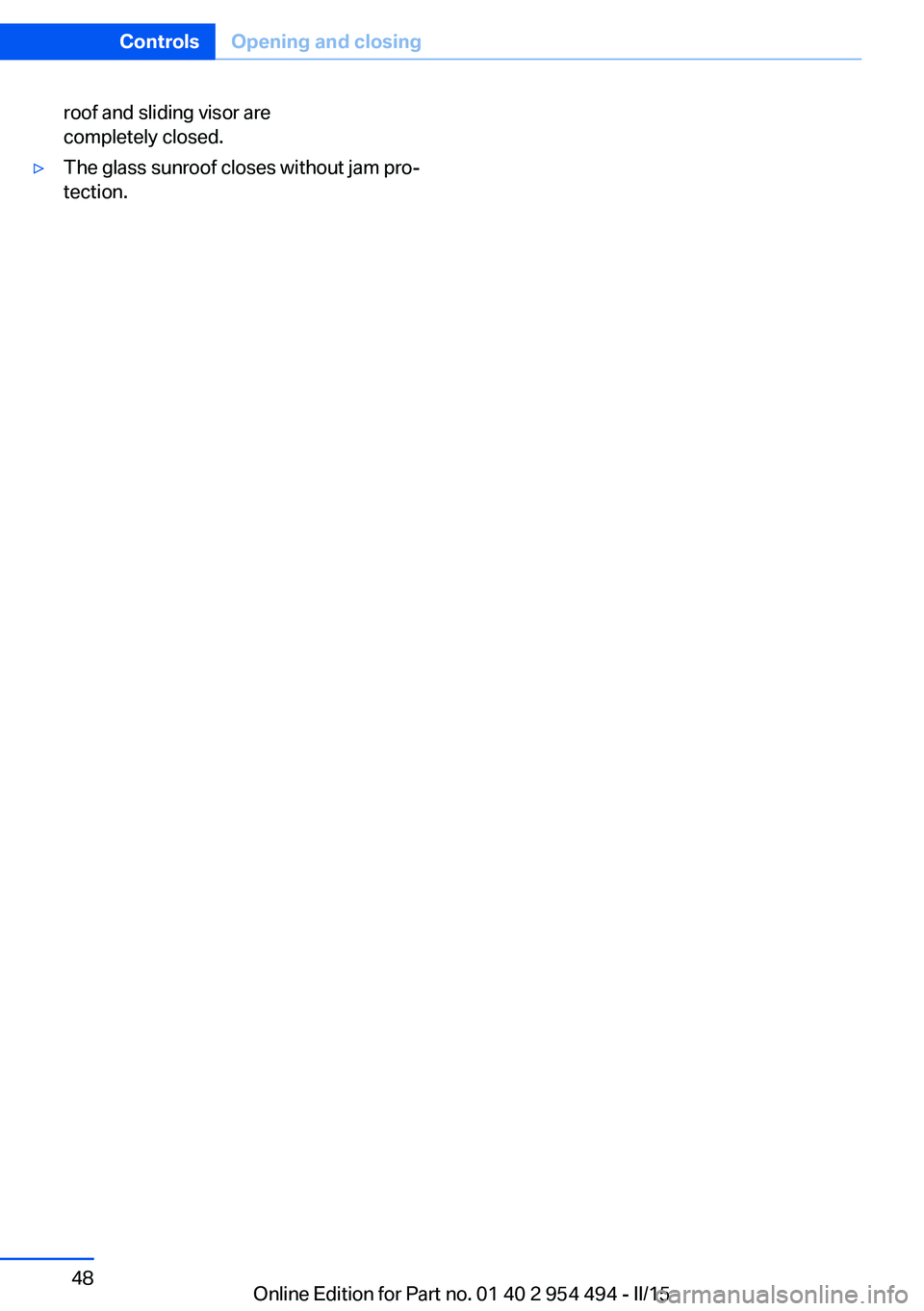
roof and sliding visor are
completely closed.‚ñ∑The glass sunroof closes without jam pro‚Äê
tection.Seite 48ControlsOpening and closing48
Online Edition for Part no. 01 40 2 954 494 - II/15
Page 131 of 251
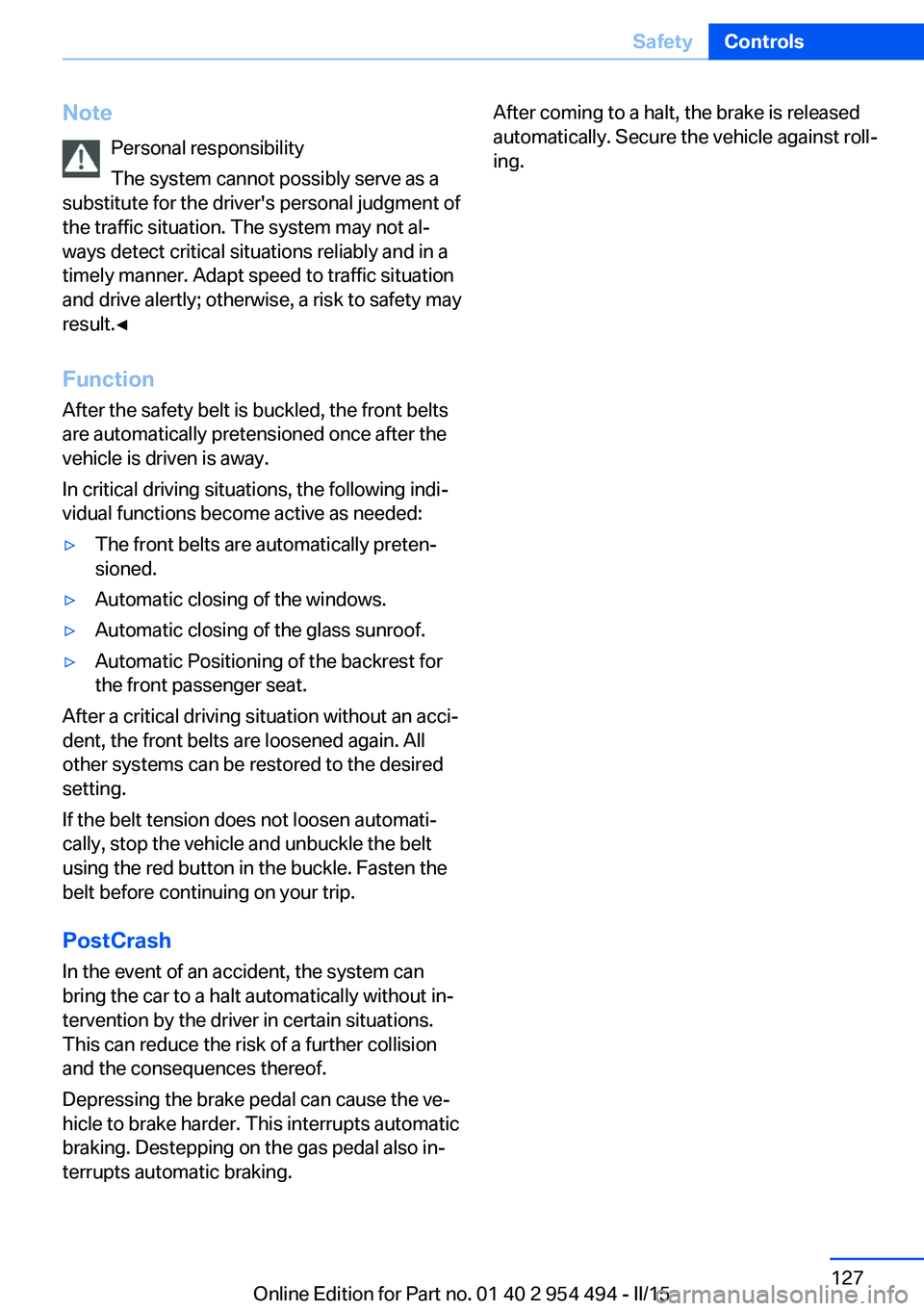
NotePersonal responsibility
The system cannot possibly serve as a
substitute for the driver's personal judgment of
the traffic situation. The system may not al‚Äê
ways detect critical situations reliably and in a
timely manner. Adapt speed to traffic situation
and drive alertly; otherwise, a risk to safety may
result.‚óÄ
Function
After the safety belt is buckled, the front belts
are automatically pretensioned once after the
vehicle is driven is away.
In critical driving situations, the following indi‚Äê
vidual functions become active as needed:‚ñ∑The front belts are automatically preten‚Äê
sioned.‚ñ∑Automatic closing of the windows.‚ñ∑Automatic closing of the glass sunroof.‚ñ∑Automatic Positioning of the backrest for
the front passenger seat.
After a critical driving situation without an acci‚Äê
dent, the front belts are loosened again. All
other systems can be restored to the desired
setting.
If the belt tension does not loosen automati‚Äê
cally, stop the vehicle and unbuckle the belt
using the red button in the buckle. Fasten the
belt before continuing on your trip.
PostCrash
In the event of an accident, the system can
bring the car to a halt automatically without in‚Äê
tervention by the driver in certain situations.
This can reduce the risk of a further collision
and the consequences thereof.
Depressing the brake pedal can cause the ve‚Äê
hicle to brake harder. This interrupts automatic
braking. Destepping on the gas pedal also in‚Äê terrupts automatic braking.
After coming to a halt, the brake is released
automatically. Secure the vehicle against roll‚Äê
ing.Seite 127SafetyControls127
Online Edition for Part no. 01 40 2 954 494 - II/15
Page 178 of 251
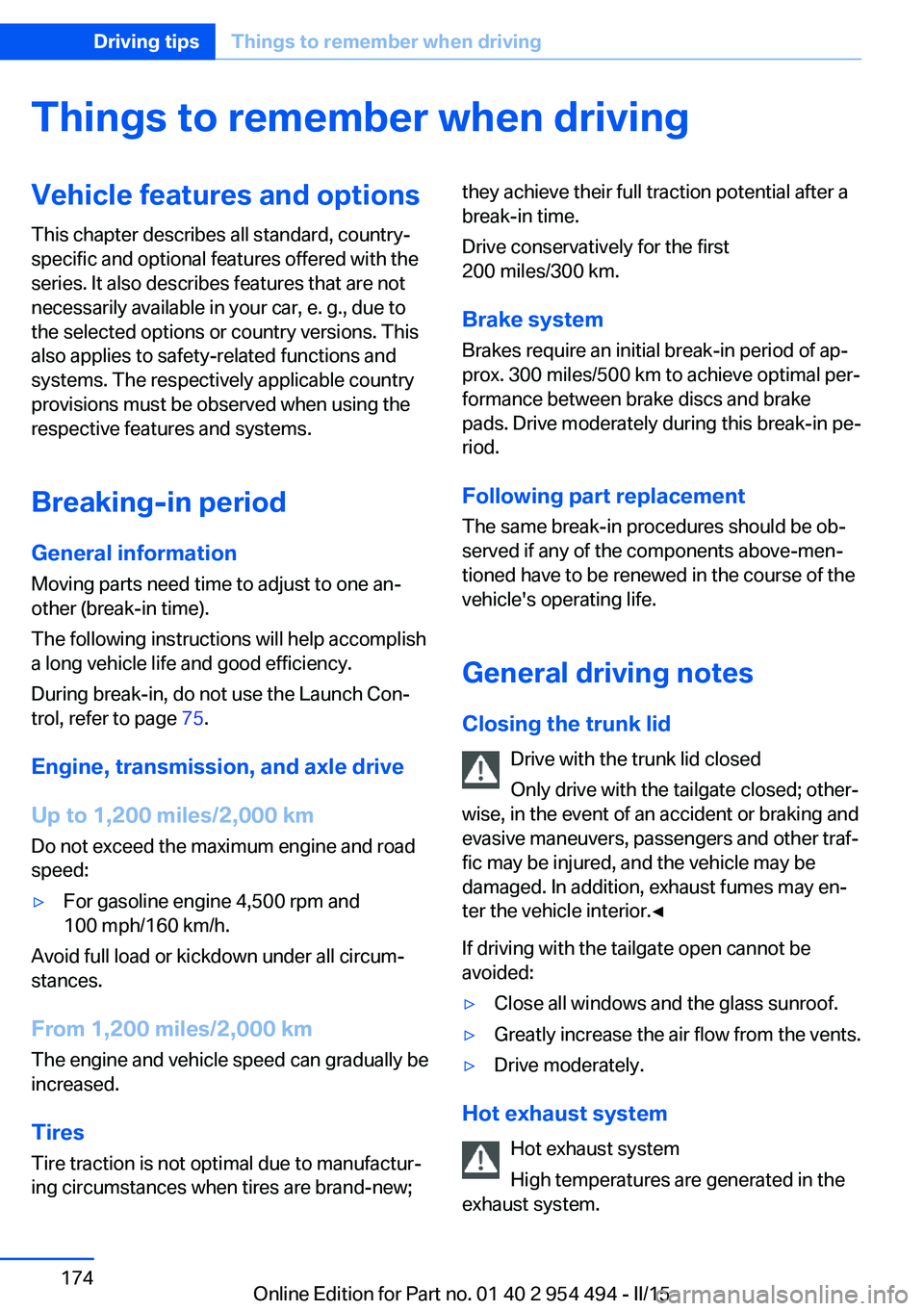
Things to remember when drivingVehicle features and options
This chapter describes all standard, country-
specific and optional features offered with the
series. It also describes features that are not
necessarily available in your car, e. g., due to
the selected options or country versions. This
also applies to safety-related functions and
systems. The respectively applicable country
provisions must be observed when using the
respective features and systems.
Breaking-in period General information
Moving parts need time to adjust to one an‚Äê
other (break-in time).
The following instructions will help accomplish
a long vehicle life and good efficiency.
During break-in, do not use the Launch Con‚Äê
trol, refer to page 75.
Engine, transmission, and axle drive
Up to 1,200 miles/2,000 km
Do not exceed the maximum engine and road
speed:‚ñ∑For gasoline engine 4,500 rpm and
100 mph/160 km/h.
Avoid full load or kickdown under all circum‚Äê
stances.
From 1,200 miles/2,000 km The engine and vehicle speed can gradually be
increased.
Tires
Tire traction is not optimal due to manufactur‚Äê
ing circumstances when tires are brand-new;
they achieve their full traction potential after a
break-in time.
Drive conservatively for the first
200 miles/300 km.
Brake system
Brakes require an initial break-in period of ap‚Äê
prox. 300 miles/500 km to achieve optimal per‚Äê
formance between brake discs and brake
pads. Drive moderately during this break-in pe‚Äê
riod.
Following part replacement
The same break-in procedures should be ob‚Äê
served if any of the components above-men‚Äê
tioned have to be renewed in the course of the
vehicle's operating life.
General driving notes
Closing the trunk lid Drive with the trunk lid closed
Only drive with the tailgate closed; other‚Äê
wise, in the event of an accident or braking and
evasive maneuvers, passengers and other traf‚Äê
fic may be injured, and the vehicle may be
damaged. In addition, exhaust fumes may en‚Äê
ter the vehicle interior.‚óÄ
If driving with the tailgate open cannot be
avoided:‚ñ∑Close all windows and the glass sunroof.‚ñ∑Greatly increase the air flow from the vents.‚ñ∑Drive moderately.
Hot exhaust system
Hot exhaust system
High temperatures are generated in the
exhaust system.
Seite 174Driving tipsThings to remember when driving174
Online Edition for Part no. 01 40 2 954 494 - II/15
Page 183 of 251
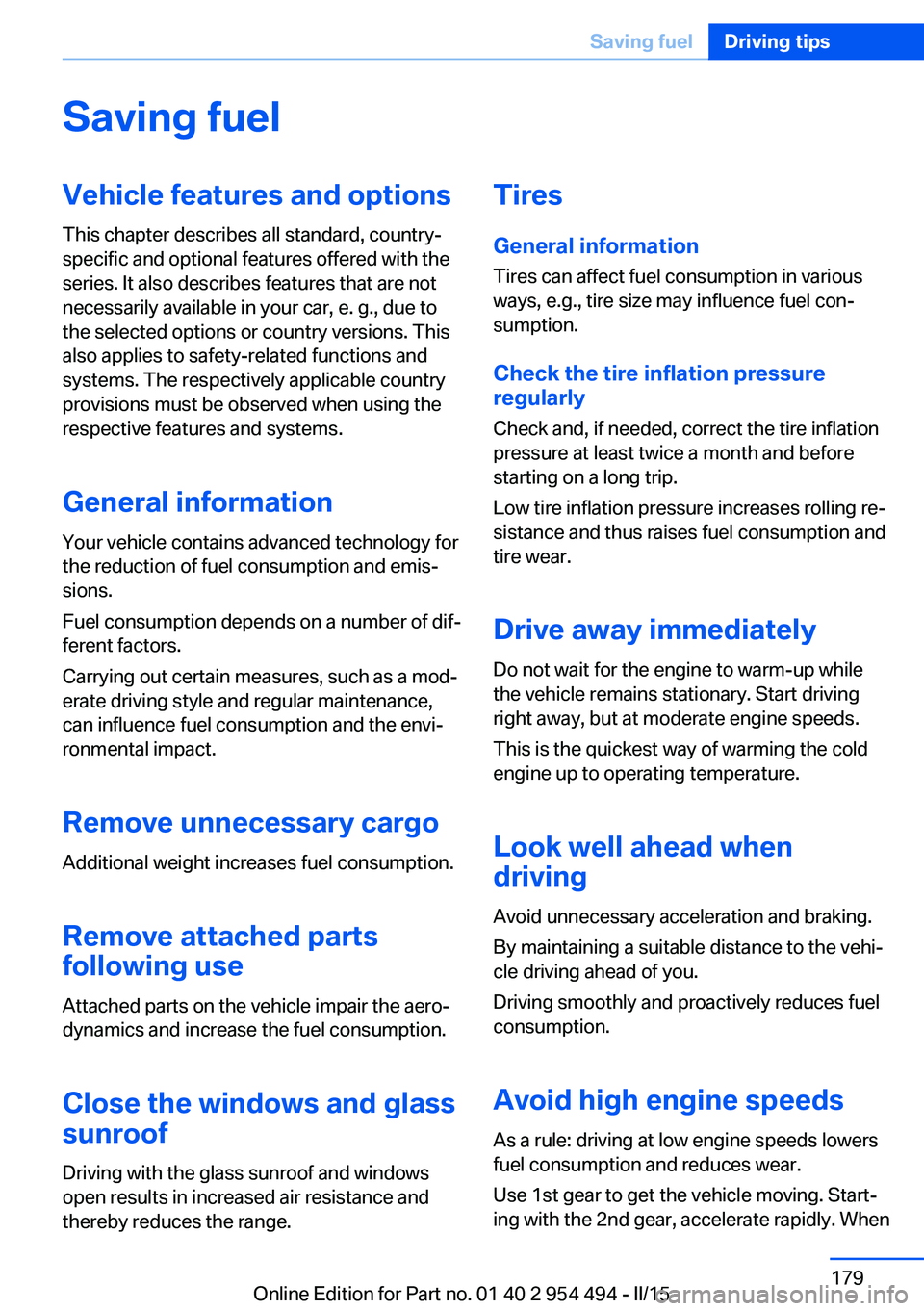
Saving fuelVehicle features and optionsThis chapter describes all standard, country-
specific and optional features offered with the
series. It also describes features that are not
necessarily available in your car, e. g., due to
the selected options or country versions. This
also applies to safety-related functions and
systems. The respectively applicable country
provisions must be observed when using the
respective features and systems.
General information Your vehicle contains advanced technology for
the reduction of fuel consumption and emis‚Äê
sions.
Fuel consumption depends on a number of dif‚Äê
ferent factors.
Carrying out certain measures, such as a mod‚Äê
erate driving style and regular maintenance,
can influence fuel consumption and the envi‚Äê
ronmental impact.
Remove unnecessary cargo
Additional weight increases fuel consumption.
Remove attached parts
following use
Attached parts on the vehicle impair the aero‚Äê
dynamics and increase the fuel consumption.
Close the windows and glass
sunroof
Driving with the glass sunroof and windows
open results in increased air resistance and
thereby reduces the range.Tires
General information
Tires can affect fuel consumption in various
ways, e.g., tire size may influence fuel con‚Äê
sumption.
Check the tire inflation pressure
regularly
Check and, if needed, correct the tire inflation
pressure at least twice a month and before
starting on a long trip.
Low tire inflation pressure increases rolling re‚Äê
sistance and thus raises fuel consumption and
tire wear.
Drive away immediately
Do not wait for the engine to warm-up while
the vehicle remains stationary. Start driving
right away, but at moderate engine speeds.
This is the quickest way of warming the cold
engine up to operating temperature.
Look well ahead when
driving
Avoid unnecessary acceleration and braking.
By maintaining a suitable distance to the vehi‚Äê
cle driving ahead of you.
Driving smoothly and proactively reduces fuel
consumption.
Avoid high engine speeds
As a rule: driving at low engine speeds lowers
fuel consumption and reduces wear.
Use 1st gear to get the vehicle moving. Start‚Äê
ing with the 2nd gear, accelerate rapidly. WhenSeite 179Saving fuelDriving tips179
Online Edition for Part no. 01 40 2 954 494 - II/15